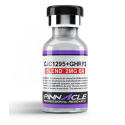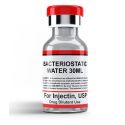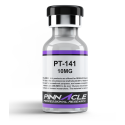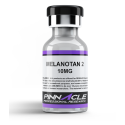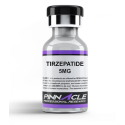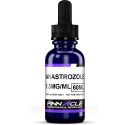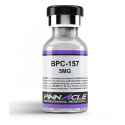The Battle of the GLP-1 Agonists: Semaglutide vs. Tirzepatide
This website's contents, articles and product information are all provided purely for educational and informational purposes. The products that are offered on this platform are only meant to be used in in vitro research. The word "in vitro," which comes from the Latin "in glass," describes research that is done outside of a living creature. It is important to remember that these products are not pharmaceuticals or medicines, and the FDA has not approved them for use in the diagnosis, treatment, or prevention of any illnesses or disorders. It is legally forbidden for these goods to be ingested by humans or animals.
Obesity and diabetes are rising globally, with over 650 million adults obese and over 422 million living with diabetes as of 2022 [1]. With lifestyle changes like diet and exercise falling short for many patients, new medications provide hope for better weight management and blood sugar control. Two of the most promising new drugs on the market are the GLP-1 receptor agonists semaglutide and tirzepatide. But with both medications touting considerable weight loss benefits, how do you choose between them?
This comprehensive article will compare the two glucagon-like peptide-1 (GLP-1) agonists semaglutide and tirzepatide, examining their similarities and key differences in efficacy for weight loss and diabetes treatment, side effects, administration and dosing, cost, and availability. With an in-depth look at the evidence, you’ll gain valuable insights to help determine which of these new obesity and diabetes drugs may be the right fit for your needs.
What Are Semaglutide and Tirzepatide and How Do They Work?
Semaglutide and tirzepatide belong to a class of medications known as glucagon-like peptide-1 (GLP-1) receptor agonists. Here is an overview of how these drugs work:
- GLP-1 is an appetite-reducing hormone secreted by the intestines in response to food intake. It signals satiety and fullness to the brain [2].
- GLP-1 also slows stomach emptying, reduces glucagon secretion, and increases insulin release - all of which lower blood sugar [3].
- In people with obesity or diabetes, GLP-1 secretion and effects may be impaired, leading to reduced satiety signals [4].
- GLP-1 receptor agonists are compounds engineered to mimic the effects of natural GLP-1 in the body. They bind to and activate GLP-1 receptors located throughout the body.
- Activating the GLP-1 receptor triggers a cascade of beneficial effects including appetite suppression, delayed gastric emptying, increased insulin production, and weight loss [5].
Semaglutide, sold under the brand names Ozempic® and Rybelsus®, is a GLP-1 analog developed by Novo Nordisk.
Tirzepatide, sold as Mounjaro®, is a synthetic dual GLP-1/GIP receptor agonist developed by Eli Lilly. It activates both the GLP-1 and GIP (glucose-dependent insulinotropic polypeptide) receptors.
Both once-weekly injectable semaglutide and tirzepatide have been approved by the FDA for chronic weight management, along with diet and exercise. But there are some pharmacological differences between them that impact efficacy and tolerability.
Efficacy for Weight Loss and Diabetes Treatment
Weight Loss Efficacy
- In the SUSTAIN trial, semaglutide 1mg weekly produced an average weight loss of 14.9% after 68 weeks compared to just 2.4% weight loss with placebo [6].
- The SURMOUNT trials found tirzepatide led to superior weight reductions of 12.4-21.4% across doses from 5mg to 15mg after 72 weeks, compared to 5.7% for placebo [7].
- At the maximum approved doses, tirzepatide 15mg produced slightly greater weight loss compared to semaglutide 1mg.
- This enhanced weight lowering effect is likely due to tirzepatide's stronger dual activation of GLP-1 and GIP receptors compared to semaglutide's sole GLP-1 activity [8].
A1c Reduction in Diabetes
- For improving glycemic control in patients with type 2 diabetes, both meds lowered A1c by 1.0-1.5% on average when added to metformin in clinical trials [9,10].
- The glucose-lowering benefits appear broadly similar between the two drugs when used specifically for diabetes management rather than weight loss.
In summary, both semaglutide and tirzepatide show impressive efficacy for weight loss and diabetes treatment. However, tirzepatide demonstrates an edge for weight reduction at the highest approved doses thanks to its dual receptor agonism. But semaglutide remains highly effective, outperforming many other anti-obesity medications.
Side Effects and Safety Profile
When evaluating powerful new medications like semaglutide and tirzepatide, it is crucial to understand their potential side effects and safety risks:
- The most frequent side effects for both drugs are gastrointestinal in nature, including nausea, vomiting, diarrhea, and constipation. These result from delayed gastric emptying.
- In large clinical trials, gastrointestinal issues were reported in up to 20% of tirzepatide patients compared to approximately 10% with semaglutide [11].
- Tirzepatide's greater receptor activation likely accounts for the slightly higher nausea and vomiting rates, especially during initial dose titration.
- There are also serious risks to be aware of like acute pancreatitis and gallbladder disease. GLP-1 drugs have been linked to a low risk of pancreatitis, likely stemming from changes in pancreatic enzymes and inflammation [12].
- Impaired gallbladder emptying can also occur, raising the chance of painful gallstones. Prompt medication discontinuation is warranted if pancreatitis or cholelithiasis occur.
- Regarding diabetes complications, a few studies have associated semaglutide with worsening diabetic retinopathy. But tirzepatide showed a neutral or positive effect on retinopathy progression in phase 3 trials [13].
In summary, semaglutide and tirzepatide have broadly similar safety profiles. But tirzepatide may cause more GI upset, especially early on. Discussing your medical history and any side effect concerns with your provider is key to selecting the best medication for your needs and tolerability.
Administration, Dosing and Availability
There are some important distinctions between semaglutide and tirzepatide when it comes to administration, dosing schedule, and availability:
Administration:
- Both drugs are administered as subcutaneous injections (under the skin) using prefilled pen devices designed for weekly self-injection at home.
- Injections are given once weekly for steady medication exposure with minimal peaks and troughs.
Dosing:
- Semaglutide is available in fixed doses of 0.25mg, 0.5mg, and 1mg (the maximum dose).
- Tirzepatide uses a variable dose that starts low at 2.5mg and is gradually increased every 4 weeks up to 15mg.
- This titration dosing helps improve tirzepatide's tolerability and allows the most effective dose to be reached for each patient.
Availability:
- Semaglutide was originally sold only as Ozempic, but the first generic semaglutide products gained FDA approval in 2022.
- Tirzepatide was approved in 2022 and remains available only as the brand name Mounjaro currently.
In summary, both provide convenient weekly self-administered injections, but tirzepatide offers flexible dosing to optimize benefits and tolerability on an individual basis. The availability of generic semaglutide also improves access and affordability compared to brand-only tirzepatide.
Cost and Insurance Coverage
The costs and insurance coverage associated with semaglutide and tirzepatide are important considerations when selecting between them:
- If you were to buy Semaglutide, it originally cost the same as the sole branded Ozempic, with monthly costs approaching $1,000 without insurance [14].
- The introduction of generic semaglutide in 2022 significantly lowered costs. Current prices range from $25-$150 per month supply without insurance [14].
- Tirzepatide was approved in 2022 and remains only available as the expensive brand name Mounjaro, with a list price around $1,349 per month [15].
- As a new brand medication, tirzepatide often faces more insurance barriers like prior authorization requirements or high copays and coinsurance.
- With time, tirzepatide may follow a similar path to generic development and improved insurance coverage like semaglutide.
When choosing between the medications, have an in-depth discussion with your insurance provider regarding specific drug coverage and your expected out-of-pocket costs based on your plan details. The prescription costs can vary widely based on individual insurance benefits.
Key Considerations in Choosing Between Semaglutide and Tirzepatide
When comparing semaglutide vs tirzepatide, there are good arguments to be made for both medications:
Reasons some may prefer tirzepatide:
- At maximum doses, tirzepatide provides superior weight loss results compared to semaglutide's maximum dose based on clinical trials.
- Tirzepatide's flexible dose-escalation may improve tolerability and reduce GI side effects.
- Early evidence suggests less diabetic retinopathy progression with tirzepatide.
Reasons some may lean towards semaglutide:
- Semaglutide has a longer, 4+ year track record of proven safety and efficacy.
- Generic semaglutide options can significantly reduce costs compared to brand-only tirzepatide that is for sale.
- In some studies, semaglutide resulted in slightly lower rates of nausea and vomiting compared to tirzepatide.
Key factors to weigh:
- If maximizing weight loss is the priority, tirzepatide appears very promising.
- If reducing medication costs is most important, generic semaglutide may be the best value currently.
- Balance efficacy, side effects, and prescription costs for your personal situation.
- Discuss all benefits and risks with your provider to decide if tirzepatide or semaglutide is the right obesity and diabetes treatment for your needs.
Both injectable GLP-1 agonists provide substantial advantages for managing weight and blood glucose when combined with diet, exercise, and other lifestyle measures. Having an open conversation with your doctor will help determine if newer tirzepatide or established semaglutide is the better selection for you as an individual based on your health history, priorities and preferences.
Accessing Semaglutide and Tirzepatide
As injectable prescription medications, semaglutide and tirzepatide must be prescribed by a licensed healthcare provider. However, there are both branded and generic semaglutide for sale from a number of pharmaceutical manufacturers. If you’re looking ofr where you can find Tirzepatide for sale, it remains only available under the brand name Mounjaro currently.
After obtaining a valid prescription, these drugs can be purchased from traditional and online pharmacy retailers. The costs and insurance coverage considerations previously discussed will impact how much you pay out-of-pocket for these medications.
It's important to note that semaglutide and tirzepatide should only be taken under close medical supervision due to potential side effects. Work with a doctor experienced in using these medications to determine if treatment is appropriate for your individual health needs. Do not attempt to source or take these prescription drugs without oversight from a healthcare provider.
When used responsibly under medical care, semaglutide and tirzepatide offer new treatment options for eligible patients struggling with obesity, weight loss, and type 2 diabetes. Discuss the pros and cons with your physician to decide if one of these medications, along with diet and lifestyle changes, may be a helpful addition to your care plan.
Here is a draft FAQ based on the article comparing semaglutide and tirzepatide:
Frequently Asked Questions About Semaglutide vs Tirzepatide
Q: What are semaglutide and tirzepatide?
A: Semaglutide and tirzepatide are both injectable medications belonging to the GLP-1 receptor agonist class used for chronic weight management and type 2 diabetes treatment. Semaglutide is sold under the brand names Ozempic and Rybelsus. Tirzepatide is sold under the brand name Mounjaro.
Q: How do they work?
A: They mimic the effects of the hormone GLP-1, activating GLP-1 receptors in the body. This suppresses appetite, slows digestion, enhances insulin secretion, and lowers blood sugar levels. Tirzepatide also activates the GIP receptor for amplified effects.
Q: What doses are used?
A: Semaglutide is available in fixed doses up to 1mg weekly. Tirzepatide uses variable dosing that is increased gradually from 2.5mg up to 15mg weekly to optimize benefits and tolerability.
Q: How much weight loss do they cause?
A: Clinical trials show average weight loss around 15% with semaglutide 1mg, and 12-21% with tirzepatide depending on the dose. Tirzepatide 15mg resulted in slightly greater weight loss compared to semaglutide 1mg.
Q: What are the most common side effects?
A: Both drugs commonly cause GI side effects like nausea, vomiting, and diarrhea resulting from delayed gastric emptying. Tirzepatide tends to have slightly higher rates based on clinical trials.
Q: How do the costs compare?
A: Semaglutide now has generic options that cost significantly less than brand-name tirzepatide. But out-of-pocket costs vary based on insurance coverage.
Q: Which is better?
A: There are good arguments for both. Tirzepatide may offer enhanced weight loss, but semaglutide has a longer safety record and lower costs. Discuss the options with your doctor.
Referenced Citations
- https://www.who.int/news-room/fact-sheets/detail/obesity-and-overweight
- https://www.ncbi.nlm.nih.gov/pmc/articles/PMC3301975/
- https://www.ncbi.nlm.nih.gov/pmc/articles/PMC6135063/
- https://www.ncbi.nlm.nih.gov/pmc/articles/PMC6135063/
- https://www.ncbi.nlm.nih.gov/pmc/articles/PMC6135063/
- https://pubmed.ncbi.nlm.nih.gov/29299307/
- https://ascopubs.org/doi/abs/10.1200/JCO.2022.40.16_suppl.4013
- https://www.ncbi.nlm.nih.gov/pmc/articles/PMC7967725/
- https://www.nejm.org/doi/full/10.1056/nejmoa1800460
- https://www.canadianjournalofdiabetes.com/article/S1499-2671(21)00066-2/fulltext
- https://ascopubs.org/doi/abs/10.1200/JCO.2022.40.16_suppl.4013
- https://www.ncbi.nlm.nih.gov/pmc/articles/PMC6135063/
- https://care.diabetesjournals.org/content/44/Supplement_1/472-P
- https://www.goodrx.com/semaglutide
- https://www.goodrx.com/mounjaro




